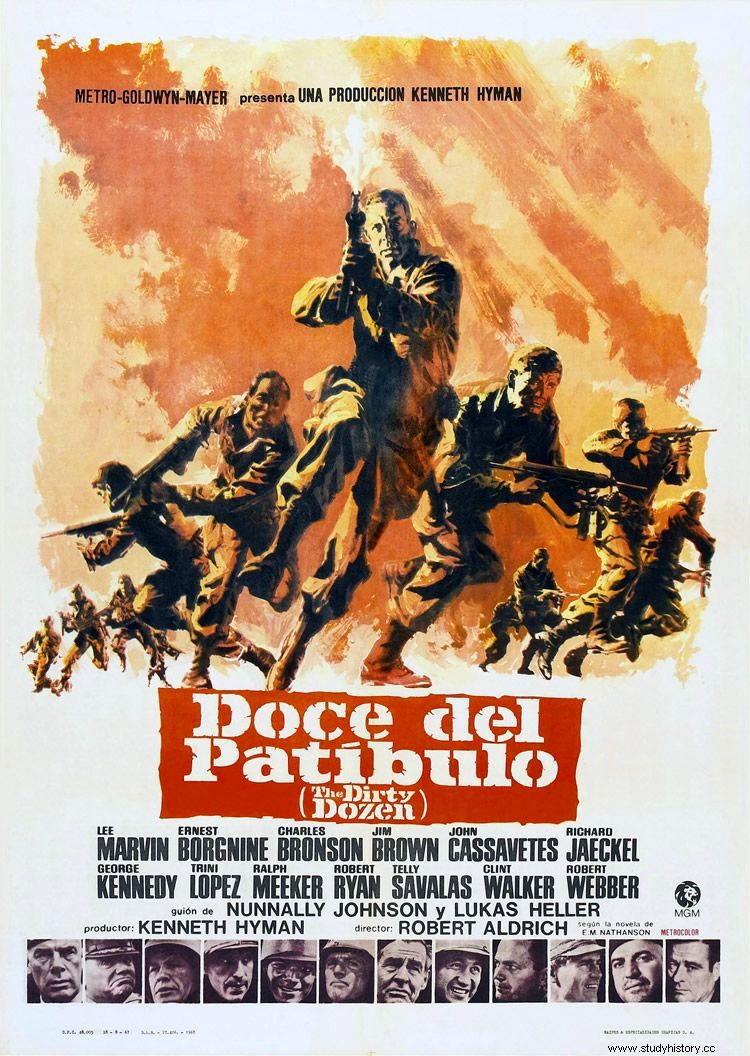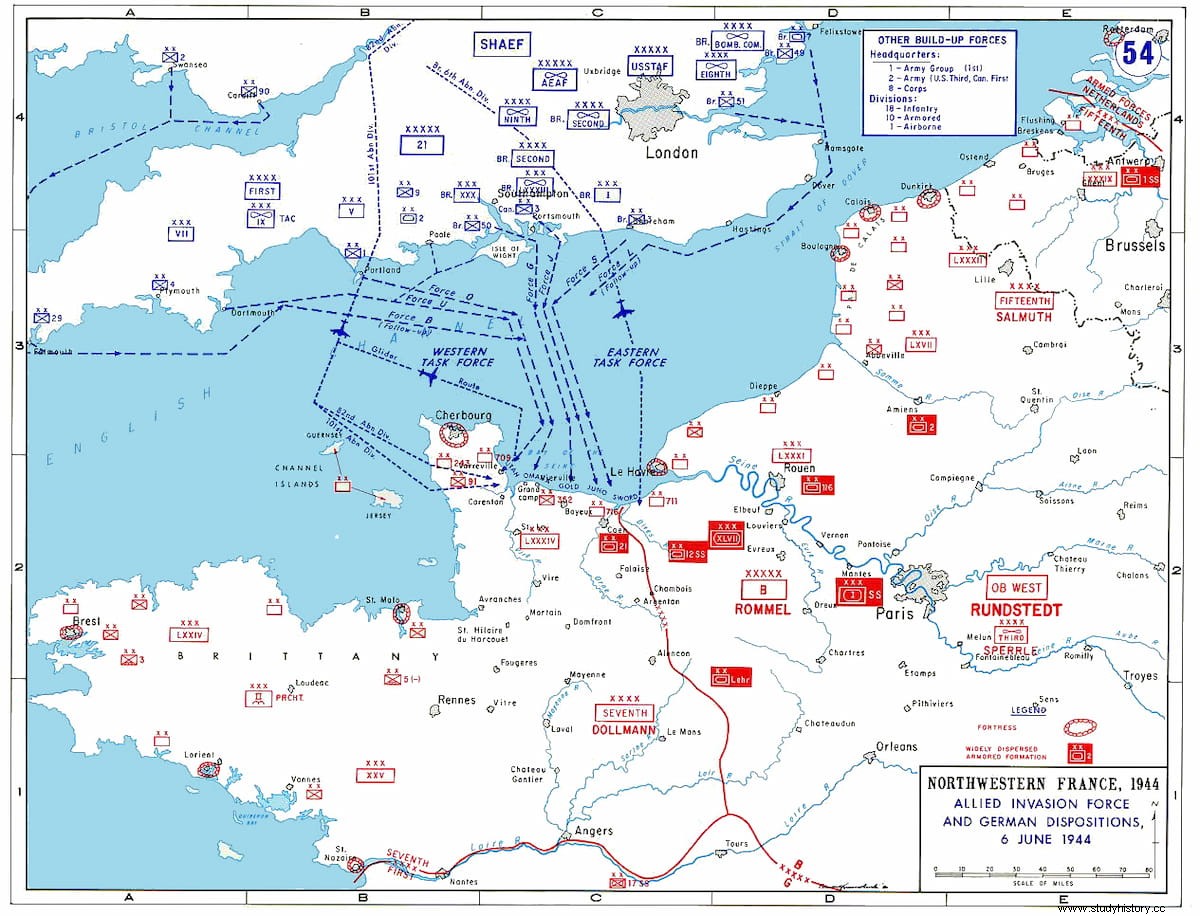Do you remember Twelve from the gallows (The Dirty Dozen , 1967)? Lee Marvin plays a major of the OSS (Office of Strategic Services, the precedent of the CIA) who, during World War II, is commissioned to gather a group of dangerous inmates to form them as guerrillas with the aim of assaulting a mansion. French where they are going to meet German high command and kill the largest number of them. These men have nothing to lose because many carry long sentences, even capital punishment, so they accept and we see how, despite their moral standing, they redeem themselves.
Well, curious as it may seem, the film is inspired by a real body that also had a similar name, halfway between the title of that film and the title of Inglourious Basterds from Trantino, which also has a slightly similar plot. We're talking about the Filthy Thirteen (Dirty Thirteen), which actually constituted the 1st Demolition Section of the 506th Parachute Infantry Regiment, framed in the famous US 101st Airborne Division, and were in charge of somewhat special missions.
Surely many fans of the subject will also be familiar with that 506th Regiment because, likewise, it has been immortalized in fiction. In this case for the small screen, since he starred in the television miniseries Blood Brothers (Band of brothers ). His badges were an eagle on his sleeve and an ace of spades on his helmet, earning him the nickname Currahee by the name of the mountain at their camp in Georgia;currahee is a word that means "to be alone" and comes from the Cherokee language. As we will see, it will not be the only relationship with the North American natives.

Under the command of Colonel Robert Sink, who had the singularity of being the only one to remain in command of the same regiment throughout the war, the 506th achieved a high degree of training that led it, for example, to break the world record for march (the 1st Battalion covered the 190 kilometers that separated the camp from Atlanta in 75 hours and 15 minutes) and to take part in some of the most outstanding actions of the war, such as Operation Overlord (where he suffered half of the casualties recorded that campaign), Operation Market Garden (in which he captured four of the five assigned bridges) or the Battle of the Bulge (resisting heroically in Bastogne).
But here we are going to refer only to the 1st Demolition Section, destined to carry out sabotage behind enemy lines and, therefore, subjected to a harsh discipline that, in some aspects, was somewhat reminiscent of the Spartan:for example, they did not bathe for days because they saved the water for, at the weekend, feasting on illegally obtained game, sometimes stolen from other camps, during their quartering in Niessen, England. It is not clear if this custom is what gave them the nickname of Filthy or this was due to the harsh nature of their missions; maybe both.
Each unit consisted of thirteen men, two groups of six plus a sergeant whose name was James Elbert McNiece, alias Jake , under the command of Lieutenant Charles Mellen. McNiece was born in 1919 in Oklahoma and had gained experience in handling explosives working first in construction and later in the fire department, before enlisting in 1942. His character, brave, rebellious and insubordinate, led him to try to make the most of it. possible and they assigned him the position of non-commissioned officer in the 1st Section.
McNiece had ancestors among the Choctaw and he is credited with giving the unit a distinctive image, with shaven heads leaving a Mohawk-style crest and donning war paint before going into combat. They were things contrary to the regulations, but several of those soldiers were of indigenous blood and, moreover, they used to do them shortly before boarding the planes, when there was no going back; on the other hand, it was taken for granted that the Filthy Thirteen they were as incorrigible - more than once they got into a fight with the Military Police - as they were indispensable, starting with their sergeant.
This was the true leader of the unit and was even more so from June 6, 1944, the famous D-Day , when the paratroopers, integrated into the 3rd Battalion of the 506th, were dropped on Normandy and Lieutenant Mellen was killed in action, leaving him in command. Given the nature of their mission, to capture the Douve River Bridge and take Carentan, in the heart of the German rear, the Filthy Thirteen they recorded an enormous casualty rate that forced them to send them continuous replacements until they practically completely renewed their ranks.
That's why the soldiers who later participated in Market Garden , on the Dommel River (Eindhoven), were no longer the same; many of them also did not survive the German bombardments and reinforcements were again needed. In that operation, by the way, McNiece was promoted to platoon sergeant and his previous position was filled by Jack Womer who, coming from the Rangers and trained by British commandos, he would be the only Filthy original that would survive alongside McNiece.

After his stint in the Netherlands, McNiece voluntarily signed up as an instructor with the Pathfinders (Scouts), joint American-British body created during the war to mark jumps, mark collection zones, determine landing sites and other airborne actions. The sergeant had had enough lead and hoped he would never see combat again, but he was wrong:the Pathfinders They were launched on the Belgian town of Bastogne with the mission of containing the German counteroffensive in the Ardennes.
Half of the Filthy Thirteen The survivors had followed their sergeant, so here they were, back on the front lines, this time with an extra enemy:the cold, which, along with the snow, the mud, the isolation, the lack of supplies, and the Teutonic armor put them on edge. in serious trouble. US casualties in Bastogne were staggering, 80-90%, but unusually, the Pathfinders they only lost one man and successfully accomplished their mission because the CRN-4 beacon they carried allowed the air force to come to the aid of the 101st Airborne Division's desperate situation.
McNiece would still have another intervention, this time in 1945 and already on a dying Germany, near Prüm. It was during the so-called Operation Varsity , the last large-scale of World War II and the largest airborne of the entire war, which was intended to ensure control of the Rhine. Despite some errors in its development and the high number of casualties, it ended with an Allied victory and with the indomitable sergeant notching another milestone on his resume:his fourth combat jump, something unusual for a parachutist.
The exploits of the Filthy Thirteen They were remembered in several articles. One of them, published by True Magazine , was the starting point for the novel Doce del patíbulo , by the writer Erwin M. Nathanson, who combined that story with another he had heard about a suicide unit made up of prisoners, although it seems that, after investigating it, he found nothing and concluded that it was a legend.
In any case, the adaptation of the novel to the cinema two years later in that amusing blockbuster directed by Robert Aldrich did not displease the survivors of the 1st Section and one of them, Jack Agnew, explained that a third of what he told was more or less faithful (especially in drunkenness and fights); the main differences that he highlighted, argument aside, was that they were not convicts and that almost half of them had native blood in their veins, unlike the Twelve , most of which were played by white actors (John Casavettes, Charles Bronson, Telly Savalas, Donald Shuterland…).
Discharged in February 1946, Sergeant James Elbert McNiece went to work for the Postal Service. He was married twice and had three children. In 1997, a historian from the same hometown of his, Richard E. Kilibane, began to collect recordings of McNiece's adventures told by himself and with them published in 2003 a book entitled The thirteen inglourious bastards , who recovered the memory of his exploits and those of his companions to the point that France decided to award them the Legion of Honor. Right on time because he passed away in January 2013; he was only survived by Jack Womer, who expired eleven months later.
